Sights and Activities
Below are the places we saw and activities completed while visiting Israel:
Jerusalem
Haas Promenade: we walked down this walkway at dawn that offered spectacular views of the Old City and the sunset.
Jaffa Gate/Gate of the Friend: in Hebrew it is known as Jaffa Gate and in Arabic as the Gate of the Friend. This was the gate we used the most to enter the Old City. It was widened in 1898 to build a road.

Tower of David: the complex started its life as the 1st-century palace of Herod the Great. After Herod’s death the palace was used by the Romans as their Jerusalem residence until it was largely destroyed by Jewish rebels in 66 CE. The Byzantines, 250 years later, mistook the mound of ruins for Mt Zion and presumed that this was David’s palace, therefore the name Tower of David. As Jerusalem changed hands, so did the possession of the complex, passing to the Muslim armies and then to the Crusaders, who added the moat. The majority of its present form took place in 1310 under the Mamluk Sultan Malik an-Nasir. The complex contains nice gardens, great views from the towers, a large scale model of Jerusalem, but the highlight of our visit was the museum that tells the entire history of Jerusalem and gave us a better understanding of the importance to so many people.

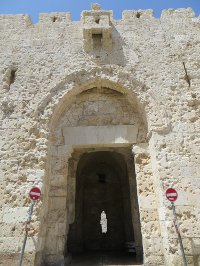
Zion Gate/Gate of the Jewish Quarter: in Hebrew it is known as the Zion Gate and in Arabic as the Gate of the Jewish Quarter.
Israel Museum: the museum contained many exhibitions on Israeli/Jewish culture and history. The Shrine of the Book exhibition contains the Dead Sea Scrolls, which total 800 in all. These biblical scrolls were found in 1947 and date back to the time of the Bar Kochba Revolt in AD 132– 35. The museum also boasts a huge outdoor 1:50 scale model of Jerusalem as it was towards the end of the Second Temple era. The sculpture garden part of the museum has work by Moore, Rodin, and Picasso. The inside exhibitions focus on Jewish ethnography, which features Jewish dress around the world.
Mahane Yehuda Market: we walked around and had lunch in this market crammed with fresh fruit, oils, nuts, vegetables, and anything else grown or picked from the Israeli soil.
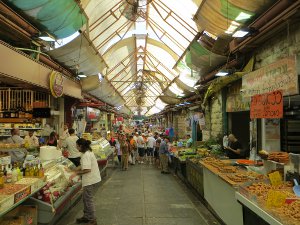
Mea She’arim Neighborhood: we walked through Jerusalem’s oldest ultra-Orthodox Jewish neighborhood. It was developed by ultra-Orthodox Eastern European immigrants who modelled their Jerusalem home on the ones they remembered, Eastern European ghettos of the 1880s. Despite their transition to Israel, residents have maintained the customs, habits, and dress. Fashions are conservative, including black fedoras, hats, for men, ankle-length dresses for women, thick padded coats, and fur hats. A few of the most traditional families, women shave their heads and wear wigs covered by a beret. Yiddish is the preferred language on the street as the ultra-Orthodox believe Hebrew to be a language only fit for religious purposes. Families are typically large and therefore make this neighborhood one of the fastest growing neighborhoods in Jerusalem.
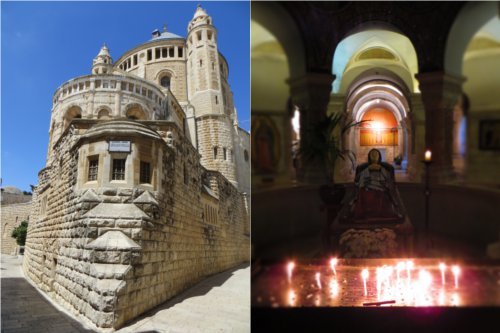
Church & Monastery of the Dormition: located on Mount Zion it is the traditional site where Christians believe the Virgin Mary died, or fell into ‘eternal sleep.’ The crypt features a stone effigy of Mary asleep on her deathbed with Jesus calling her to heaven.
King David’s Tomb: the location of the site is highly disputable, but this is still one of the most respected Jewish holy places. It serves as a prayer hall and the room is divided into sides for men and women.
Room of the Last Supper: we entered the room where Christians believe Jesus and his disciples had their final meal together, considered to be the fourth most holy place in the Christian world. It is believed that the disciples received the Holy Spirit on the Pentecost here and started speaking in ‘foreign tongues.’ The event culminated with the baptism of 3000 followers of Jesus, marking the birth of Christianity. The original building was the site of the first Christian church, but was destroyed twice before being rebuilt in its current form by the Crusaders.
Western Wall: we visited the most important religious shrine for the Jewish people a few times and were able to find different viewpoints within the Old City. When it was built some 2000 years ago it was just a retaining wall supporting the outer portion of the Temple Mount, where the Second Temple stood. When the temple was destroyed in 70 AD, the Jews were sent into exile and the precise location of the Temple was lost. Returning to this sacred site the Jewish people purposely avoided the Temple Mount, fearing that they might step on the Holy of Holies, the ancient inner sanctum of the Temple barred to all except the high priest.

Instead, they began praying at an exposed outer wall, known now as the Western Wall. The Wall became a place of pilgrimage during the Ottoman period and Jews would come to mourn and lament the destruction of the Temple, therefore the site is also known as the Wailing Wall. During these times, houses were pressed right up to the Wall, leaving just a narrow alley for prayer. In 1948, the Jews lost access to the Wall when the Old City was taken by the Jordanians. 19 years later, when Israeli paratroopers stormed in during the Six Day War, they fought their way directly to the Wall and their first action on securing the Old City was to bulldoze the neighboring Arab houses to create the plaza that exists today. The plaza now operates as a great open-air synagogue where it is divided into two areas: a small southern section for women and a larger northern section for men. We viewed many men rocking back and forth on their heels and bobbing their heads in prayer. Many pieces of paper stuffed into the cracks in between the stones are also noticeable. Some Jews believe that prayers and petitions inserted into the Wall have a better chance of being answered.
People Praying at the Western Wall

Lion’s Gate: known as Lion’s Gate because of the lions carved on either side of the archway. It is also the gate where Israeli paratroopers fought their way in on June 7, 1967 to capture the Old City from the Jordanians.
Via Dolorosa: we walked down the route where Christians believe that Jesus took as he carried his cross to Calvary and therefore were his last steps. This route has changed several times throughout history, for example in the Middle Ages, Latin Christianity was divided into two camps and each of the two groups claimed routes primarily visiting chapels belonging to either one. In the 14th century, the Franciscans devised a walk of devotion that included some of the present day stations, but had as its starting point the Holy Sepulchre. This was eventually modified by the desire of European pilgrims to follow the order of events of the gospels, finishing at the believed site of the Crucifixion rather than beginning there. And finally, if historians had their way, the route would probably begin outside the Citadel, as this was the residence of Pilate when he lived in Jerusalem.
Church of the Holy Sepulchre: the holiest Christian site in the Old City, where Christians believe Jesus was nailed to the cross, died, and rose from the dead. There are many chapels inside representing all the Christian denominations. We did not wait in the long line to see the so-called tomb of Jesus.
Damascus Gate/Nablus Gate: in Arabic known as the Damascus Gate and in Hebrew as the Nablus Gate. This was the main entrance to the city as early as the first century BC.

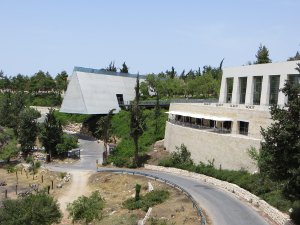
Yad Vashem Museum: in 1953, a plan was made to memorialize the six million Jews who died at the hands of the Nazis and honor those who tried to save them. This museum was the result, a landscaped complex with a visitor’s center, museum, and a dozen memorials scattered over the Mount of Remembrance. The name of the museum, Yad Vashem, taken from the bible means ‘A Memorial and a Name.’ The architect of the building, Moshe Safdie, explains that the triangular design represents the bottom half of the Star of David, because the population of Jews worldwide was almost cut in half as a result of the Holocaust.
Temple Mount/Noble Sanctuary: after a second attempt we were successful at entering one of the largest disputed holy grounds. Our first attempt at entering was halted by the Israeli forces that did not open the gates due to a large group of Jews gathered outside the entrance. Anytime the officers think there will be trouble they decide not to open the doors. The next day we were fortunate to enter this open plaza of cypress trees and ancient paving stones, which has not changed much since the first Muslim conquest, around 1400 years ago, but the history of the mount goes back much further. The first Jewish temple was built here a thousand years before Jesus. Known to Muslims as Al-Haram ash-Sharif (Noble Sanctuary) and Jews as Har HaBayit (Temple Mount), started with a large slab of rock protruding from the ridge of Mt Moriah. According to Jews, this rock was identified as the foundation stone of the world, where God gathered the earth that was used to form Adam. The first Jewish temple was destroyed in 586 BC and the Second Temple was erected in 515 BC later to be destroyed in 70 AD. According to many Orthodox Jewish authorities, Jews are forbidden from visiting the Temple Mount because they may accidentally step on the sacred ground on which the Temple once stood. Only the high priest could enter the temple and he did so once a year on Yom Kippur, but now the location of the holy sanctum is unknown. In the mid seventh century in Mecca, Muslims believe that the Prophet Mohammed announced to his fellow Meccans that in a single night he had travelled to the ‘farthest mosque’ and led other prophets in prayers. Mohammed did not mention Jerusalem by name, but the farthest mosque was interpreted to be Al-Haram ash-Sharif, thus making Jerusalem a holy place for Muslims. The Temple Mount is considered Islam’s third-holiest place after Mecca and Medina and the same slab of rock the Jewish worship is believed that Mohammed ascended to the heavens. After the 1967 Six Day War, Israelis handed control of the Temple Mount to Jerusalem’s Muslim leaders.
Dome of the Rock: the jewel in the Temple Mount is the gold plated mosque, Qubbet al-Sakhra in Arabic. The dome covers a slab of stone sacred to both the Muslim and Jewish faiths, as described above in Temple Mount/Noble Sanctuary section. The building was constructed between 688 and 691 AD and the dome is covered with 1.3mm of gold donated by the late King Hussein of Jordan. We admired the beauty of the structure from the exterior for quite a long time, but unfortunately only Muslims are allowed to access the interior.
Church of the Ascension: located on the Mount of Olives and adjacent to a hospital, this church was built by the Kaiser of Germany and completed in 1910. We climbed the bell tower with great views of Jerusalem.
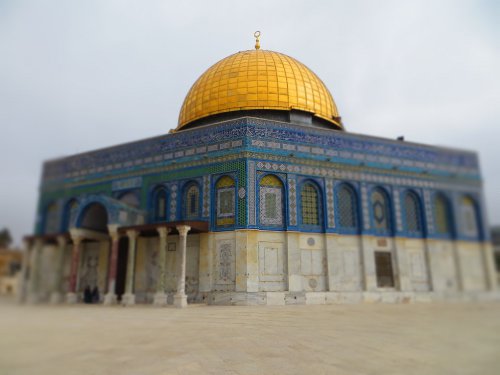

Church of All Nations: designed by architect Antonio Barluzzi and dedicated in 1924, the church features golden mosaics that depict Jesus assuming the suffering of the world. Therefore, the church’s alternative name is the Basilica of the Agony. 12 countries financed the construction of the church, which their flags were allocated in the ceiling of the church.
Tomb of Virgin Mary: we visited one of the holiest sites in Christianity. On her death, in the middle of the first century, Mary was supposedly buried here by the disciples.
Bethlehem
Church of Nativity: the oldest continuously operating church, commissioned in 326 CE by Emperor Constantine. We waited about an hour in line to see the 14-pointed silver star marking the spot where Christians believe Jesus was born.
St. Catherine Church: this church, located next to the Church of the Nativity, is famous for its midnight mass broadcasted across the world on Christmas Eve.
Manger Square: we walked around the Old City of Bethlehem and its main square, which is not the image that many people have of a village with a barn, especially with a modern Starbucks located near the Church of Nativity. The best attraction was the little souq, open air market, with its range of fruit and vegetables, meat and fish, shoes, and junk.
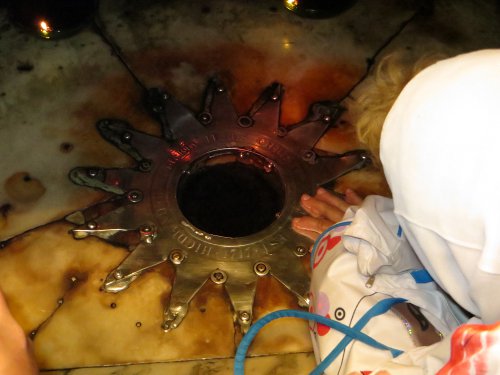
Tel-Aviv
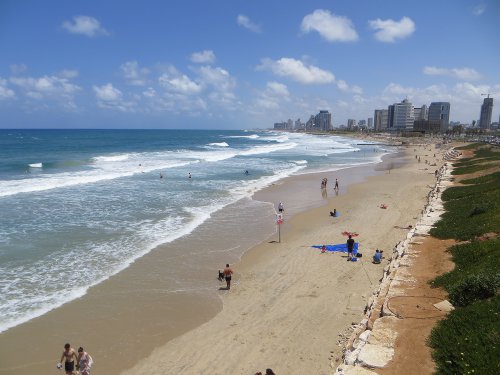
Old Jaffa: we took a stroll around the small curvy streets of the oldest remains of the city, Jaffa, dating back thousands of years. The adjacent garden, HaPisgah, were also very pleasant to walk around with panoramic views of the Tel Aviv.
HaTachana (Old Railway Station): once a train terminus of the rail line to Jerusalem, it now has been reopened to the public and transformed into a tourism center with cafes, restaurants and boutique shops.
Neve Tzedek: walking around this neighborhood, whose name means ‘Oasis of Justice,’ reminded us of parts of Los Angeles that have been gentrified. This was Tel Aviv’s first Jewish neighborhood, which was founded in 1887.
Rothschild Boulevard: this large upscale boulevard lined with palm trees was named after the famed Jewish family of financiers. Lining the boulevard on both sides are sleek restaurants, bars, and Bauhaus buildings while its shaded central strip is a pedestrian and cyclists heaven.
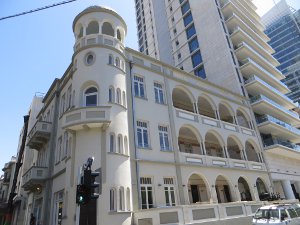
Old Port (Namal): originally opened in 1936 to give Tel Aviv sea trafficking independence from Jaffa, the port soon went into decline with the construction of a better, deeper harbor at Ashdod. In the early 2000’s the Tel Aviv municipality overhauled the area by creating a wide wooden boardwalk and transforming the warehouses into a commercial center.
Dizengoff Square: located on a raised platform over the street, the square features a Fire and Water Fountain, designed by Ya’acov Agam, known for his rainbow color scheme designs.
Carmel Market: the market is considered the heartbeat of Tel Aviv, vendors shouting as they try to sell everything from fresh flowers to fruits and vegetables.
Haganah Museum: this museum chronicles the formation and activities of the Haganah, the military organization that was the forerunner of today’s Israel Defense Forces (IDF). Originally, the Haganah was a guerrilla force working against the British Mandate.

Park HaYarkon: we walked along the Yarkon River, which crosses the city’s largest green space.
Beit Hatefutsoth Museum: also known as the Diaspora Museum, we spent a few hours learning about the Jewish people. The museum tells the epic story of the Jewish exile and global Diaspora with an excellent collection of films, photographs, models, dioramas and presentations.
